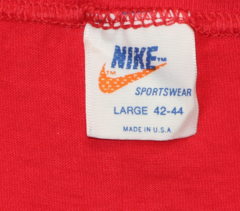Vintage Nike Labels - The Complete History
- Stijn Buschgens
- Jul 19, 2021
- 3 min read

Since Nike first designed clothes with the world-famous “Swoosh” in 1971 (which by the way was designed by student Carolyn Davidson for $35). The designs of the neck labels, composition labels, and the Swoosh itself have been continuously adapted and renewed, making it very easy for people with a little vintage shopping experience to find out what time a vintage Nike item comes from.
To make identifying your vintage Nike item a little easier, we've made this guide, so that you too know exactly from which time your swooshy gems come from!
Early Nike Labels (1970s - 1983)
A white tag, with the Brand name in blue letters and an orange Swoosh are characteristic of this label. The fabric from which the label is made is very thin compared to later labels.
This label has been in use the longest of all labels. Nike started producing clothing with this label in 1971. In 1973 Nike entered into a collaboration with Brown and Partners, a large marketing agency that turned the then not so well-known Swoosh into a truly global brand. the advertisements that resulted, in 1980 Nike had a share of more than 50% of the entire sports shoe market. In the same year, Nike also became a publicly traded company.

At that time, Nike still almost only used the label and variants of it, which can be seen in the pictures above. These tags were used up to and including 1983, after which a new label was introduced in 1984.
The Blue-tag era (1984-1988)
Nike items from this era carry a blue label with a silver-grey logo and silver-grey text. The color that indicates the size of the article is usually (but not always) yellow.
In 1984 Nike signed a multi-million dollar deal with up-and-coming basketball star Michael Jordan, becoming the new face of what Nike wanted to radiate. This was also the year when perhaps the most famous brand slogan ever “Just do it” was first used in the branding of the brand. The three iconic words came back in television commercials, billboards and of course designs of clothing.

Sweatshirts, T-shirts, and especially jackets and cardigans from this era are generally considerably brighter in color and design than clothing from the previous era. This fit better with Nike's new image as a fresh, eye-catching sports brand.
The Silver Tag Era (1987-1994)
The collaboration with MJ blossomed into a mega success. Nike opened its first store, Niketown in Portland, Oregon. A flagship store that mainly served as a business card for the brand. NikeTown quickly became very popular among fans and enthusiasts of the brand, so that a branch soon opened its doors in Chicago and later also London. In 1993, Nike's value grew to $3 billion, officially making it bigger than Reebok, which had been the largest player in the market until then.
white-black-red labels (1994-1999)
The successor of the silver labels are the white-black-red labels. These are often square, but sometimes also rectangular in shape and can be recognized by the color combination. The Nike name is also a bit closer to the swoosh, so the letter “E” hangs over it a bit.
Other variants from this period are even rarer, such as the cross-training labels and the Nike Premier tags (our hearts skip a little when we come across them!) that were especially prevalent in the late 90s.
In 1994, Nike continued to build an even stronger brand image and brand awareness by building more collaborations with iconic athletes and emerging talent from all branches of sport. One of the most successful collaborations of this era is the collaboration with top golfer Tiger Woods. 1994 was also the year in which Nike presented another well-known representation of its brand, in the form of product placement in the film Forrest Gump. In the film, which became a huge hit, Nike shoes play a significant role and are portrayed very recognizable at various moments.

The Gray Label Era (2000s)
This label looks a bit like the silver tag from the 90s, but differs from it in that the whole label is grey, no longer the brand name, only the swoosh can be seen and it is not in the middle but a little lower right of the label is located.
This is the last label confirmed by Nike in T-shirts. Modern Nike labels exist and are still made, but have been replaced in T-shirts by a print in the form of a flex print. Labels can often still be found in jackets, coats, trousers, sweaters and accessories from after this period and in modern production, but we do not consider these to be vintage.
Hopefully you have now managed to find out what era your favorite vintage nike items come from. Still not sure? Send a DM to @wildebrasvintage on Instagram or an email to stijnbuschgens@gmail.com.
Then we'll figure it out for you!

























